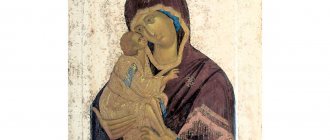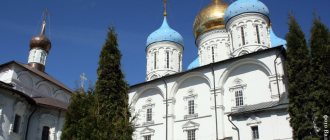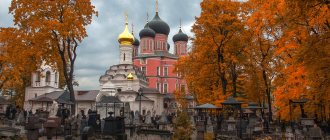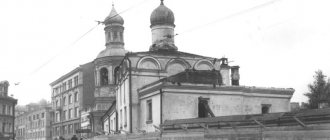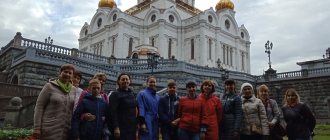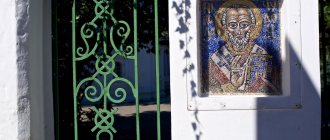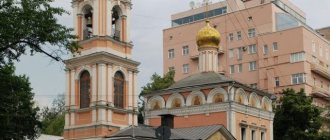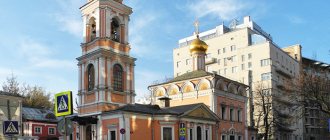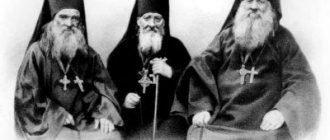| St. blgv. Prince Daniil of Moscow |
Daniil Alexandrovich
(1261 - 1303), Prince of Moscow, blessed Commemoration March 4, August 30 for the discovery of relics, in the Cathedral of Moscow Saints
Born in 1261, he was the youngest, fourth son of St. Alexander Nevsky and Righteous Vassa. When he was two years old, he lost his father. The time of his mother’s repose is not indicated in the chronicles; it is only known that she was buried in the church in honor of the Nativity of Christ in the Vladimir Dormition Monastery (Princess Monastery) and was considered righteous by the surrounding residents.
In 1272 [1] he received Moscow and its surrounding lands as an appanage. The Moscow principality was small and unenviable in those days, but over time, the matured noble prince Daniel strengthened and enlarged it.
Already in 1272, he founded the Krutitsky monastery with a temple in the name of the apostles Peter and Paul. Then the noble prince built a temple on the banks of the Moscow River and a monastery attached to it in the name of his patron, the Venerable Daniel the Stylite.
In 1283, with his brother Andrei, he acted against his older brother, Vladimir. book Dimitri. When Andrei took the grand-ducal table, Daniel acted against him in alliance with his nephew Ivan, Prince. Pereyaslavsky, and uncle Mikhail Tversky (1296).
When in 1293, Grand Duke Andrei Alexandrovich, together with the Tatars called from the Horde, led by Tudan (Dyuden (“Dudenev’s Army”), devastated the Russian cities: Murom, Suzdal, Kolomna, Dmitrov, Mozhaisk, Tver, the noble prince decided to let them into Moscow, to save the people from destruction. There was no strength to fight back. Together with his people, the prince experienced the hardships of ruin and robbery. Defending his rights, Saint Daniel was forced in 1295 to speak out against his brother near a place called Yuryevo Tolchische, but even here the desire for the world won in it, and bloodshed was avoided.
In 1300, when the Ryazan prince Konstantin Romanovich, calling on the Tatars for help, was engaged in secret preparations for a surprise attack on the lands of the Moscow principality, the Monk Daniel went with an army to Ryazan, “by some cunning” defeated the enemy, captured Constantine and destroyed many Tatars ( 1301). This was the first victory over the Tatars, a quiet victory, but wonderful - like the first impulse towards freedom. Having defeated the Ryazan prince and scattered his allies - the Tatars, the noble prince Daniel did not take advantage of the victory to take away foreign lands or take rich booty, as was customary in those days, but showed an example of true non-covetousness, love and brotherly love.
The holy prince never took up arms to seize foreign lands, he never took away property from other princes either by violence or deceit. For this, the Lord expanded the borders of his possessions. John Dimitrievich, prince of Pereyaslavl-Zalessky, nephew of Daniel, meek, pious and benefactor of the poor, respected and loved his uncle. In 1302, dying childless, he transferred his principality to Saint Daniel. The Pereyaslavl land, together with Dmitrov, was the first after Rostov both in the number of inhabitants and in the fortress of the main city. Pereyaslavl-Zalessky was well protected on all sides. Andrei, who had long been “encroaching” on Pereyaslavl, sent his boyars and tiuns to the latter; but Daniel drove them out of there and installed his governors there. The holy prince remained faithful to Moscow and did not move the capital of the principality to Pereyaslavl, which was stronger and more significant at that time. This annexation made the Moscow principality one of the most significant. Here was the beginning of the unification of the Russian land into a single powerful state.
In 1303, the prince became seriously ill. He accepted the great schema and ordered himself to be buried in the Danilov Monastery. Out of deep humility, he wanted to be buried not in the church, but in the general monastery cemetery.
On March 4, 1303, the blessed Prince Daniel died.
Less than 30 years had passed since the repose of the blessed Prince Daniel, when the Danilevsky monastery founded by him was transferred to the Kremlin in 1330, the church was turned into a parish, and the cemetery became secular.
During the time of Grand Duke John III (1462 - 1505), the Monk Daniel reminded forgetful descendants of himself. An unknown person appeared to the young man from the entourage of the Grand Duke and said: “Do not be afraid of me - I am a Christian and the lord of this place, my name is Daniel, Prince of Moscow, by the will of God I was placed here. Tell Grand Duke John from me: you console yourself, but you have forgotten me, but God has not forgotten me.”
From that time on, the Grand Duke established the singing of cathedral memorial services for relatives - the princes. During the time of Tsar Ivan the Terrible, at the tomb of the Monk Daniel, the dying son of a Kolomna merchant was healed. The Tsar, struck by the miracle, restored the ancient Danilov Monastery and established that the Metropolitan and the Holy Cathedral should annually conduct a procession of the cross to the burial place of the blessed prince and serve a memorial service there.
In 1652, the blessed Prince Daniel was glorified by the discovery of the holy incorruptible relics, which on August 30 were transferred to the church in honor of the Holy Fathers of the Seven Ecumenical Councils. The holy relics were placed in a shrine “for the glorification of the Holy Trinity and for the healing of the infirm.”
Metropolitan of Moscow Platon (Levshin) (+ 1812) in the Life of the Holy Prince, compiled by him, writes:
“This original founder laid the foundation for the present greatness of Moscow, paving for this with quiet feet only a small path. For, like any building, constructed not with extreme haste, but only with great skill and diligence, it receives special hardness and remains indestructible for a long time; and just as a tree, growing for many centuries, having first begun with a small twig, gradually thickens, and its branches spread far around, so this city had to grow from small but solid beginnings, so that its first shine would not darken the eyes of the envious and so that at first not to be shaken and fall sooner than it has grown in height. This is how the founder prepared this great city, giving it, although small, but not interrupted by any breath of wind, and gave the great glory of its exaltation to his son, Grand Duke John Danilovich, nicknamed Kalita.
Danilovsky Monastery
The fate of the Danilovsky Monastery turned out to be surprising. After the death of its founder, it existed for some time, and then became impoverished, and for a certain period even the memory of it completely disappeared in Rus'. But, as Orthodox legends say, miracles began to happen at this place.
Legends indicate that Saint Daniel of Moscow began to appear to people and speak to them. Other amazing things also happened and sick people were healed. Since there was a lot of such evidence, under Ivan the Terrible, a new church was built on the site of the Danilovsky Monastery. And they decided to transfer the relics of Saint Prince Daniel to the Church of the Holy Fathers of the Seven Ecumenical Councils. This happened in August 1652.
Personal life
The Moscow prince was married to Princess Agrippina (according to other sources, Evdokia ). Some historians suggest that his wife was the daughter of Lev Danilovich Galitsky and the Hungarian princess Constance. The princely couple had 10 children : Yuri, Mikhail, Alexander, Boris, Ivan, Simeon, Vasily, Afanasy, Daniil and Anna. The first-born, Yuri Daniilovich, became his father's successor after his death and in the same year annexed the Mozhaisk principality to Moscow.
Boris Daniilovich ruled Kostroma, Afanasy Daniilovich - Novgorod. Ivan I Daniilovich, Grand Duke of Vladimir, went down in history under the name Ivan Kalita.
The most famous son is Ivan Kalita
1282-1294. Construction of the Danilov Monastery, destruction of Moscow by Dudeneva’s army
In 1282, by order of the prince, on the right bank of the Moscow River, in the territory of Zamoskvorechye, the construction of the monastery of St. Daniel the Stylite (heavenly patron of the Moscow ruler) was completed. The Serpukhov road passed next to it. The monastery was named Danilovskaya. The following year, Daniel supported his brother Dmitry in ascending the Vladimir princely throne.
In 1293, Andrei Gorodetsky organized a Tatar-Mongol campaign against the Russian northeast, which was called “Dudenev’s Army.” The Golden Horde troops under the command of Tudan ravaged Moscow and Danilov's monastery.
The following year, Prince Dmitry died. Daniil Alexandrovich managed to unite his army with the troops of Tver and Pereyaslav. The main opponent of this union was Prince Andrei, who ruled in Vladimir.
Taking monastic vows
Moscow Prince Daniil Alexandrovich was a pious man, and therefore before his death he became a monk, tired of the quarrels, squabbles and cruelty of this world. This is what the chronicles of those times testify.
He died in 1303, in March. Information differs regarding the place of his burial. Some believe that his body found its final refuge in the Danilovsky Monastery, which he erected in honor of his holy heavenly patron Stylite. According to other sources, he was buried in the Church of the Archangel Michael in Moscow. Both places eventually became famous in the Orthodox world and became very visited. The last of them turned over time into the Archangel Cathedral of the Moscow Kremlin.
Thus ended the reign of Prince Daniil Alexandrovich. The Orthodox Church has not forgotten and honors his name to this day. March 17 and September 12 are considered days of his memory. He was canonized in 1791.
Creative activity
From the age of fifteen, Prince Daniil already carried out active creative work on the lands entrusted to him, which continued until the end of his life. He erected monasteries and temples, introduced changes to the procedure for collecting trade duties, increased the defense capability of the principality, striving for its independence.
The activities of Prince Daniil Alexandrovich and his policy were aimed at expanding his own lands. Naturally, wanting this, he could not avoid intrigues, struggles for power and internecine squabbles that were seriously shaking Rus' at that time. However, chronicles and folk memory, and later Orthodox traditions, attributed to him a fair love of peace and wisdom, noting his diplomatic abilities and desire to avoid blood and military conflicts.
Strengthening Moscow's influence
But the civil strife of the Russian princes, as well as their battles for thrones, continued and could not stop. The warring parties either quarreled or made peace, uniting and breaking off relations with each other. To strengthen their positions, they did not hesitate to form an alliance with the Tatars, who at that time handed out labels for the rule. The Russian princes fawned over them, just to put their rivals in their place. And this only made the foreigners stronger, their dominance stronger, which brought new ruin to Rus'.
A terrible disaster for Moscow and for fourteen other affected cities was the invasion of the Tatars and their robberies that occurred in 1293. Even remote places, wild forests and swamps were not an obstacle for them. Rus' was in dire need of a strong government capable of protecting it.
Daniil, trying to strengthen the position of Moscow, pursued his policy, acting either by conviction or by force. Soon he had the opportunity to establish himself in Novgorod, where the young son of Prince Daniil Alexandrovich became the ruler. This was Ivan, who later received the nickname Kalita and went down in history under this name.
Ivan Kalita was the fourth son of Daniel. The others were Boris, Alexander and first-born Yuri. In total, seven sons were born. Nothing was mentioned in the chronicles about daughters, and therefore whether the Russian prince Daniil Alexandrovich had them is unknown. But there is some information about his wife, a certain Evdokia Alexandrovna.
Background of the reign
Little is known reliably about the childhood years of Prince Daniil Alexandrovich. He was born in 1261, presumably in November or December, and therefore his patron saint was the Christian ascetic Daniel the Stylite, whose name is traditionally honored by the Orthodox Church on December 11. The prince later built a monastery in his honor and wore his image on his gloves. The boy's father died when he was less than two years old. And therefore he spent his childhood years with his uncle Yaroslav Yaroslavovich, the prince of Tver and Vladimir, in Tver.
The grand ducal appanage included Moscow, which at that time was governed only by governors. Therefore, Daniel’s receipt of Moscow lands after the death of his guardian did not at all predict his future rise and did not speak of the mark that he would leave in history.
Miracles granted through the veneration of the relics of a saint
When John III took the throne, God's messenger appeared to one of his comrades in a dream and ordered him to tell the ruler not to forget about the Christian faith. Remembering his pious predecessor, John III ordered memorial church services to be held.
The second appearance of the saint descended on the son of John III, Prince Vasily. One of his comrades by the name of Shuisky stood on the tombstone to climb onto his horse. The horse reared up, threw the rider to the ground and crushed him with the weight of his body. The horse died at that very moment, but the rider remained crippled. Shuisky was brought to the relics of the saint, where he repented. The saint of God forgave and healed the cripple.
Vision of God's saint to boyar Shuisky

